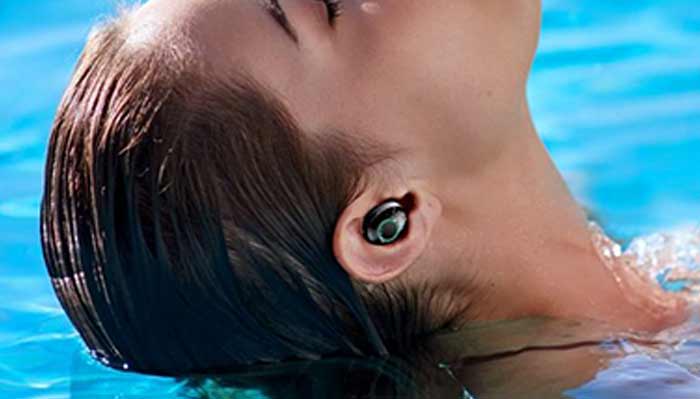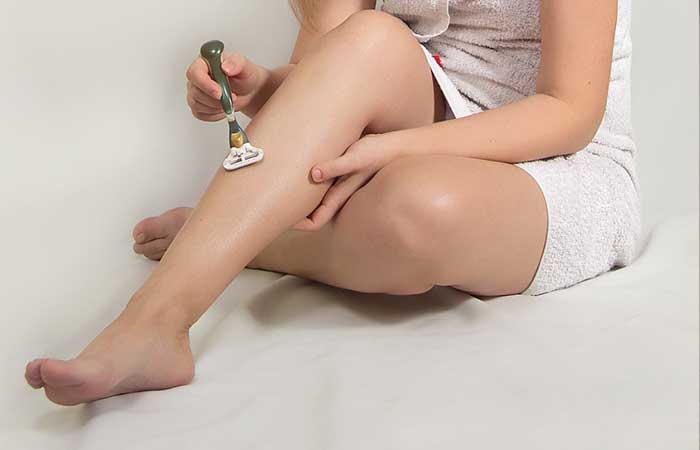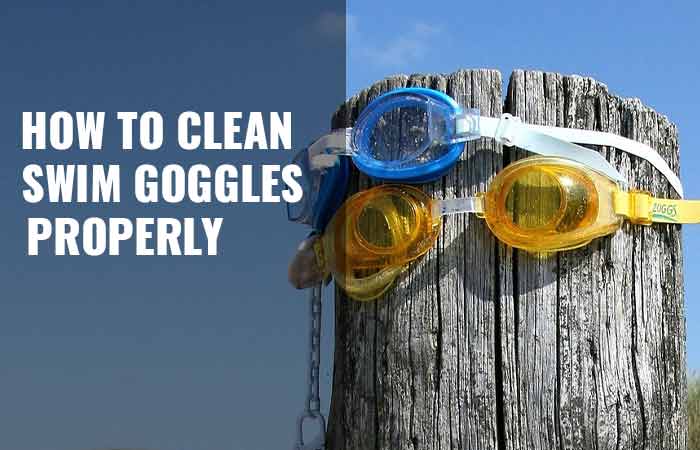How to Tread Water- Techniques, Benefits & Drills
Staying upright, afloat and still without moving in deep water can be quite tricky if you have zero water experience. The next thing you can think of is drowning and this is why water treading is necessary to help you float with your head above the water. With this skill, you can save not only your life but also some energy.
You can tread water with legs only using the eggbeater or breaststroke kick techniques. Without legs, you can stay afloat using an arm motion called sculling. Other treading styles include the scissor, flutter and bicycle kicks combined with arms. Using legs/arms only or both at the same time will depend on your treading experience.
Following are details on what exactly treading water means, how to do it correctly using the various methods with videos, benefits, drills to improve or master it, and world treading records.
Treading Water Meaning/Definition
Water treading is a way of maintaining a steady upright upper body position, your head above the surface of the water while kicking your legs and moving your hands in certain motion below the surface of the water without necessarily moving in either direction. It is a deepwater swimming skill that helps you stay afloat, effortlessly breathe while spending minimal energy.
Because of the element of staying in the same place without moving, the phrase “treading water” is often used to describe an effort expected to create motion/progress, but which actually results in merely staying in one, possibly barely sustainable, place or state.
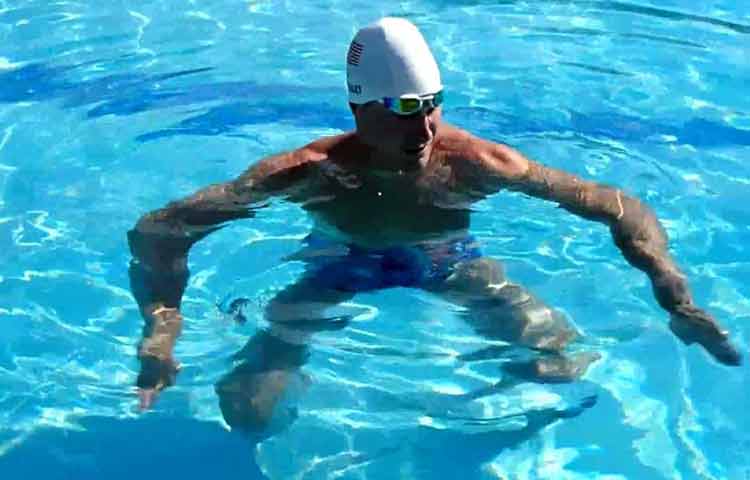
Basically, treading water can be broken down into four major parts;
- Your head a position-The head remains still and relaxed above the surface of the water.
- Upper body-should remain still and relaxed below the surface of the water
- Legs-Eggbeater, frog, scissor or flutter kicks. Details in the upcoming sections.
- Arms- Your arms perform sculling motion. It involves horizontally moving your forearms back and forth and not up and down. Your palms turn in the direction your arms are moving. Your thumbs angle slightly up on the way in, while your pinky fingers slightly up on the way out.
Further Reading: What is Sculling in Swimming? How to do it+ Drills
While there are various ways to tread water, any movements meant to help you float in an upright position without moving in any direction are considered treading water. There are known styles to tread water with swimmers adding their own variations as they become better at swimming.
Most of the techniques are actually based on the most popular swimming strokes such as the breaststroke(whip kick), front crawl (flutter kick) and the sidestroke (scissor kick).
With water treading, the focus should be on relaxing and creating just enough upward force to keep you afloat. The reason for drowning is often panic and stiffness in the body followed by frantic and disorderly motions. Treading water is the exact opposite of that.
How to Tread Water- Eggbeater & Frog Kick
The two most common types of treading techniques involve using the eggbeater kick and the modified frog kick with sculling arms stroke. Experienced swimmers can tread using only arms or legs while most beginners use both legs and arms.
Eggbeater Treading Water Technique
The eggbeater, also often referred to as rotary kick is a technique of kicking where each leg propels downwards and outwards at a time in a continuous motion. This kicking style is derived from the motions of an eggbeater, a kitchen utensil used for beating egg whites. The lower leg movements in this technique are like the motions of the kitchen eggbeater hands.
Although it is the most complex and hardest to master, the eggbeater is the most efficient water treading technique if you have healthy knees.
If you have some swimming basics, the eggbeater is actually a slightly modified breaststroke (whip/frog) kick where the kicking action involves one leg at a time. However, this technique requires more ankle flexibility and ankle rotation.
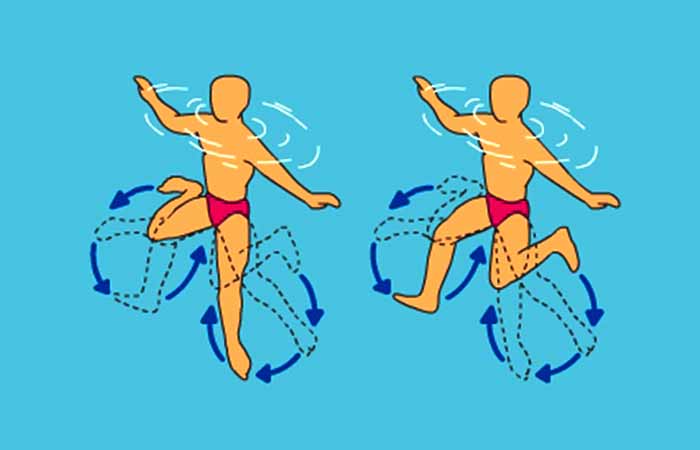
To perform the eggbeater, follow the steps below:
First, take in some air then ensure your head and upper is still and relaxed. Bend your legs such that the thigh region is parallel to the floor of the pool and forming a 90-degree angle to the back and your back should be perpendicular to the floor of the swimming pool as well…a perfect sitting position either on a chair or at the edge of the pool.
Open up the knees as far apart as naturally possible, then circle the lower legs while maintaining the position of the rest of the body. The legs should move such that, as one leg moves in a clockwise manner, the other should move in an anti-clockwise manner.
The legs should also not meet in the middle. As one comes to the middle of the body, the other should go outwards.
Once you are comfortable circling, it is time to focus on feeling the pressure of the water. As each leg kicks separately, the lower leg (from the knee through the foot) must draw up, then kick down and out and back-in, circularly.
The lower leg must rotate outside the knee with toes pointing out, and then back into the extended position with the inside of the leg and instep of the foot “grabbing and pressing” in on the water.
Advanced eggbeaters rely little on the motion of the arms. However, for a start, you can hold the hands horizontally while moving them back and forth.
With time and practice, mastering this technique becomes a reality. The recommendation is to try it out for up to 10 minutes each day. Including regular bodyweight squats and lunges in your dryland program can also help develop the strength you need.
The Frog Kick
The frog kick is yet another way to tread water. This method utilizes the frog/whip kick, the main propulsion kick for the breaststroke and elementary backstroke swimming styles, to generate upthrust and keep you afloat.
It is basically can be viewed as performing breaststroke in a vertical position. It is an easier version of the eggbeater since you simultaneously kick with both legs.
While easier to learn and more common, it is not as efficient as the eggbeater because using two legs at the same time takes quite a lot of energy.
How to do it
As mentioned earlier, your head and upper body should be still, relaxed; the head above the surface of the water and the upper body below the surface of the water.
You start by pulling your legs together such that you’re in an upright position. You then draw the feet inwards and upwards such that they’re coming towards your bottom.
The knees should be pulling outwards and away from the body. As the feet come together and almost touch, you kick outwards and downwards simultaneously to generate the upthrust needed to keep you afloat.
Adding the sculling motion with your hands will help you the right balance. This way, you’ll stay afloat.
Other Water Treading Techniques
other water-treading methods include the bicycle, scissor, flutter kicks combined with sculling and the dog paddle technique. Find more about each of these methods in the following sections.
The Bicycle Kick Technique
The bicycle kick is basically like riding an imaginary bicycle in water. The pedaling motion where each foot goes through a complete circular motion in an alternating manner is used to provide enough upthrust to keep you afloat.
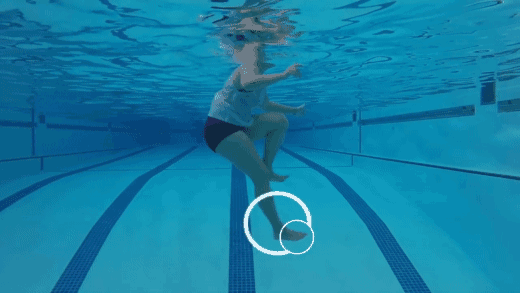
You have to perform these leg motions while in an upright position. The weakness with this position is that you’ll tend to topple to the sides. This is overcome by using the backward circular motions of the arms to steady the body.
This is among the easiest water treading techniques you can learn as it’s very natural and instinctual. It’s mostly used by scuba divers to keep an almost upright position while moving with or without equipment in their hands.
Scissor Kick Treading Water
The scissor kick is the primary kicking method for the sidestroke swimming style. This is one of the easiest treading techniques for beginners to learn because it needs only a simple opening and closing of your extended legs to provide upward momentum.
The movements a scissor kick requires are just like its name implies. Start by tucking the heels beneath the body and then extending the top leg forward while extending the bottom leg back to create a “V” shape, then close them sharply to generate force.
Open your legs again and repeat the movement.
The Flutter Kick
The flutter kick entails keeping the legs straight while alternating one in front of the other as if walking. When on a horizontal axis, the flutter kick is an effective propulsion technique. As such, you’ll be propelling your body above the water.
This treading is mostly practiced by advanced swimmers, especially freestylers and backstrokers, not necessarily to stay afloat but to strengthen their flutter kicks as well improve their kicking technique.
Just like the bicycle kick, you’ll tend to topple to the side and need the input of the hands to keep straight.
The Dog Paddle
The dog paddle is a primitive method of treading water that is seen in children when left in water. It is more instinctual than being based on any method of training. However, the fact that it works means that it can be used to save a life when there’s the risk of drowning.
This method works by waving the hands and legs in a random manner when you are on your belly facing downwards. Of note is that it’s not waving the hands above the water but in restricted motions while keeping the head above the water.
How to Tread Water Without Arms with Just Legs
Using the eggbeater and the breaststroke kick techniques are two most effective ways you can tread with legs only without hands. This is only possible after you have mastered the techniques and fundamentals of buoyancy.
Legs-only-treading is important especially when you have an issue with one or both of your arms and when carrying something with your hands for instance rescuing someone. This technique is also common when performing water sports such as water polo or synchronized swimming.
Treading Water Benefits in Swimming
What is the purpose of treading water and why is it an important skill? The reasons you need to learn how to tread water include the following:
Survival
The primary reason to learn how to tread water is to survive by preventing drowning. This can occur when you’re not yet good at swimming and there’s no lifeguard or other person to help you out.
Also, you may have injured yourself, swallowed water or are just plain tired yet the shoreline is a bit far. It may also be uneconomical to get out of the water. You may also be stoping to clean your goggles or fix your gear in the water.
Adjust Your Swimming Stroke & Form
This occurs especially when you’re learning a new swimming style or recovering from an injury.
When you’re doing a given part of a stroke poorly, you’ll need to stop and adjust it often with the input of a coach.
You’ll not need to get out of the water for this as will thus need to float about in the same position by treading water.
A Necessity for some water Sports & Professions
Sports such as water polo and synchronized swimming heavily employ water treading skills as they rely on balancing on the water and performing other parts of the sport.
Treading water is a major skill that’s even been taught in the navy to keep ready to handle difficult situations.
A good Exercise for your Arms and Legs
Water treading is a strength workout on its own since resistance from the water fires opposing muscles with every move.
Further Reading: How Many Calories Does Treading Water Burn?
World Records for Treading Water
According to a couple of sources, the world record for treading water is 132 hours ( 5.5 days). A Maltese by the name Albert Rizzo set it in 1984.
Before Rizzo, the world record stood at 85 hours (about 3-1/2 days). It was set by a 19-year-old Indian called Ashish Singhvi in 1977, courtesy of the Indian-published Limca Book of Records.
According to Guinness World Records, the longest time treading water while balancing a football on the head is 19 min 2 sec, and was achieved by Jhoen Lefont Rodriguez (Cuba) in Havana, Cuba, on 14 September 2019.
How long can you Tread Water?
With the right technique and optimum conditions, a physically fit individual can tread water between 3-5 hours or more on average. Experienced water sports athletes such as water polo players can tread water with only their legs for over 10 hours. The duration actually depends on many factors, including;
Your level of fitness-the fitter the longer you will tread.
Technique/skill level– Some treading techniques like the eggbeater, are efficient, thus will allow you to tread for a longer period.
Condition of the water– warmer and calm water will let you tread more while in cold and rough water, you won’t last long. It is also easier to stay afloat on salty seawater than freshwater.
Body Type– the bigger and fatter you are, the easier it is; the smaller, muscular and bonier you are, the more difficult.
Floating Aid-Any floating item attached to your body will increase your buoyancy, thus making staying afloat easier hence more treading time
Drills & Exercises
Further Reading
Following is a list of articles with more swimming information and other water sports
Swimming Strokes/Styles
- Different Types of Swimming Strokes, Styles & Names
- How to Swim Freestyle: Technique, Tips & Drills
- How to Swim Breaststroke: Kick, Pull, Form, Drills & Tips
- Butterfly vs Breaststroke Swimming
- How to Swim Elementary Backstroke- Technique, Drills & Tips
- How to Swim Sidestroke-Technique,Trudgen &Combat Drills & Tips
- How to Swim Backstroke-Technique, Drills & Tips
- How to Swim Butterfly: Technique, Drills & Tips
Swimming FAQs & Ideas
- Can you Swim with Contacts in the Ocean/Pool?
- Can you Open your Eyes in the Salty Ocean or Chlorinated Pool Waters?
Swimming Accessories
Pool Exercises
Other Water Sports
References
- https://umanitoba.ca/faculties/kinrec/hlhpri/media/eggbeater_kick.pdf
- https://www.independent.com.mt/articles/2004-12-21/news/the-first-ever-maltese-to-enter-the-guinness-book-of-records-70180/
- https://www.guinnessworldrecords.com/world-records/469535-longest-time-treading-water-whilst-balancing-a-football-on-the-head

